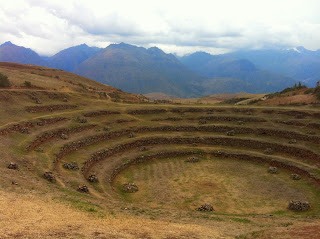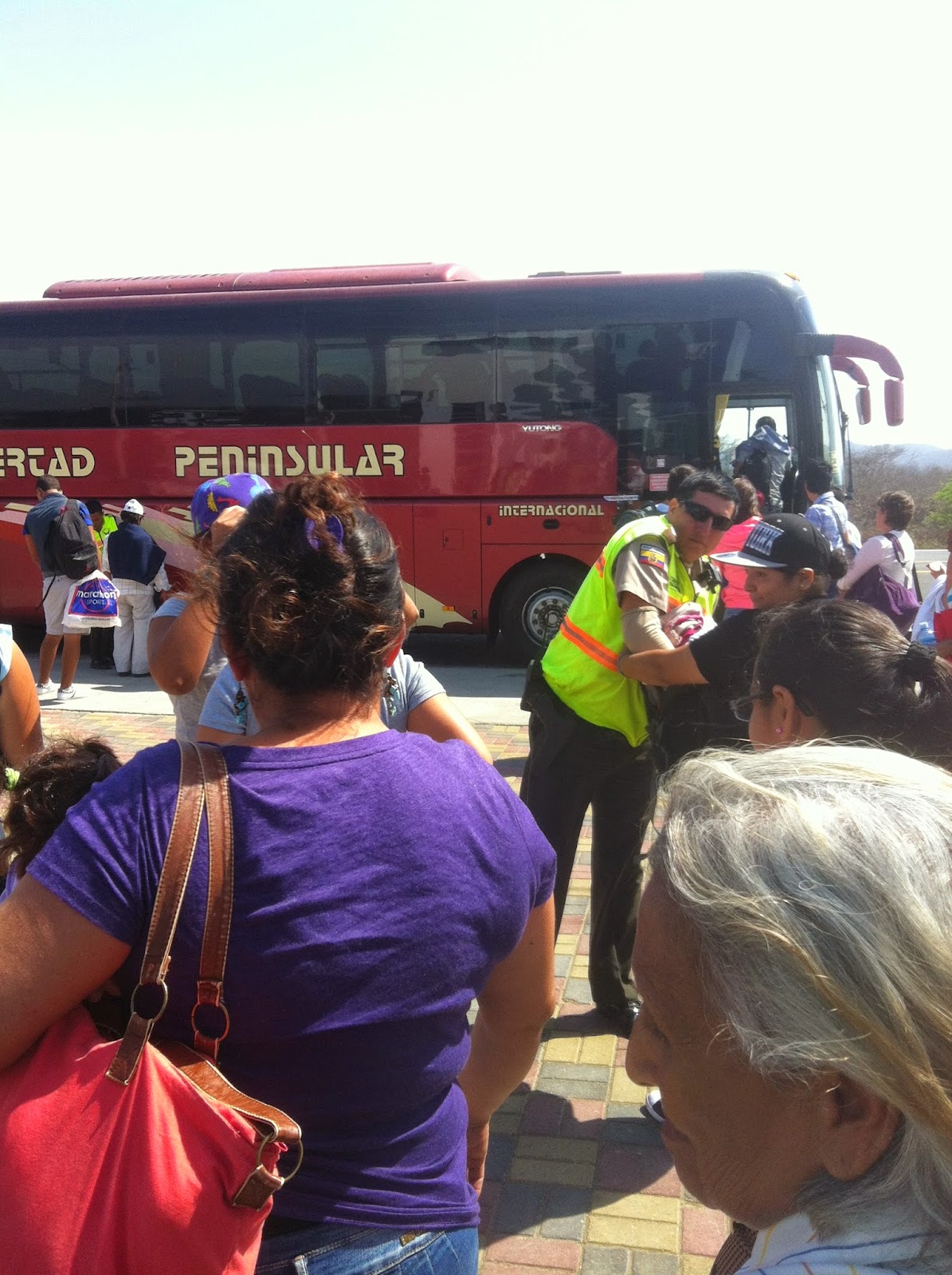Our first stop in this incredible country was a small border town called Copacabana off the shore of lake Titicaca (the highest lake in the world). The town itself didn't have much to offer other than broken ATM machines and a lack of toilet seats so we took an excursion and spent a full day on the island that was about an hour and a half boat ride away from Copa, called Isla Del Sol.
I find the longer we travel around South America the more my mentality and standard of living change. For example, I used to actually believe sign posts on hotels when they said FREE WIFI and HOT WATER. Now, we won't book a hotel ahead of time until we ask the concierge to walk us into the vacant room and turn on the hot water and wifi as proof- basically standing altogether in a small bathroom like idiots waiting for the water that's hitting my hand to turn warm. It's not that we don't trust them... Well, no that's pretty much exactly what it is. We had quite a horrible experience at a hostel that promised hot showers and complimentary breakfast. Turned out the water wasn't hot because there WAS NO RUNNING WATER PERIOD and the free bread roll in the morning was so tough it literally could have been used as a weapon. I'm not sure why but most public bathrooms we've been to in Bolivia so far come equipped with the toilet bowl, a flusher (if you're lucky - usually a woman stands outside the stall and then pours a bucket of water in the toilet after you're finished... Worst job ever I'd say) and the only other thing missing is a seat! I don't really understand the logic there. Could it be that they ran out of toilet funding to finish building the whole toilet? Or perhaps they thought the flat seat was unnecessary? Either way, it's a shitty situation... Literally. We've now learned through experience that if we come across a nice (decent) bathroom, one with a toilet seat at the very least, then I must force myself to use it since you never know if or when the next time will be. I've essentially taught myself how to pee on command. I'm still working on the whole Spanish thing though.
The buses in Bolivia are nothing like the bus companies in Peru! We wouldn't complain about the light above our heads not turning on or the vents not blowing any air because most likely they are just there for decoration anyways! On a serious note, we're lucky if our luggage is still in storage under the bus when we arrive at our destination. So far we've had two bizarre experiences with buses in Bolivia- one involving a quick exit off the bus in the middle of the night onto a motor boat that the woman who sold us our tickets "forgot to mention". We had just closed our eyes mentally preparing for a 6 hour ride and been told in Spanish to get off and on to a small boat that would take us to the other side of the lake where we would then reunite with our bus and continue driving another 4 hours. I was so confused but just relieved not to have woken up again in a Police station I suppose. Another bus ride involved waking up after 3 hours of driving to see a family of five sitting on the floor of the bus by our feet. Apparently the driver had stopped four times throughout the journey to pick up hitchhikers (even though there were no available seats) and therefore earned some extra pocket money. Each time the bus stopped to collect a random traveler on the side of the road, Adam and I would push our faces up against the glass window to make sure no one was emptying the storage compartment or having a quick shuffle through our bags. It's not that we're paranoid (ok maybe a little) but we've already heard plenty of horror stories and with lack of any security whatsoever, we have had to become a lot more aware of our surroundings.
 |
| If you look closely you will see a man hanging out in the luggage compartment. No, he does not work for the bus company. He is a random. |
La Paz- which is NOT the capital of Bolivia, was a really cool city in the desert. It seemed like there was a mix of tradition meets modernity but it somehow complimented each other. The locals were friendly and there were a lot of tourists around- just like any other metropolitan city. The hotel we stayed at had a bar on the seventh floor overlooking the snow tipped mountains and bustling city life. It was a beautiful contrast. We decided to take part in the free walking tour which we knew started at the famous San Pedro prison smack in the middle of the city. An odd place for one of the most corrupt yet unique run prisons in the world. The tour guides wouldn't let us get much closer than about 200 meters from the thick outer concrete prison walls so Adam and I had another plan. After learning about the history and kept traditions in La Paz we decided to walk back towards the prison gates to take a peak into this mythical dungeon we've heard so much about.
 |
| La Paz from the seventh floor |
 |
| Behind San Pedro Prison |
Luckily we were heading off to the city of Cochabamba where Adams friend offered to put us up in his amazing flat for the next four days and in a very comfortable double bed. Alex and his girlfriend were gracious hosts and basically gave us a walking food tour of the cities amazing cuisine and where they've been living together for the past 10 months. We toured the markets, said hi to Jesus (a larger statue than the one in Rio on top of a mountain) and tried Cows Heart on a skewer. We basically ate our way through Cochabamba and thoroughly enjoyed living like locals with familiar faces in a foreign country. What a treat!
 |
| Adam and Alex eating a feast at the food market in Cochabamba |
Next stop on the itinerary was the capital of Bolivia called Sucre. Most people confuse the capital with La Paz as this is where all the official government and Parliament buildings lie. During World War 2, we were told that even Hitler himself was confused by this, writing a telegraph to the President of Bolivia warning that Germany was going to Bomb La Paz. Mr. President wrote back in a sort of panic, not really trying to deter the situation but politely explaining that actually, Hitler was mistaken, Sucre is the capital of Bolivia... Go for them!!
We arrived in Sucre just in time to celebrate Adams 28th birthday. We had been meeting the same group of people throughout our travels and all arranged to meet in Sucre for a party the following weekend. While Adam met up with some of the Irish boys at a pub in the afternoon, the girls and I went on a secret mission to buy a cake, decorations and of course, a piñata. When in Rome, right? I took Adam to a nice steak house for dinner that night and while we were eating, some kind guests in the hostel helped decorate the lounge with balloons, streamers and party favours. When we arrived back, Adam was shocked to see that essentially these strangers and new friends came together to throw him a surprise party... In Bolivia!
We were really touched that the travellers who we had only met a few times, some only a few hours, took the time to help make Adams birthday a little more special. Unfortunately I don't remember much after leaving the hostel and heading to the club, probably because we had a little more of the "Columbian ground coffee" left over that needed finishing. My fathers biggest worry was us carrying it over the border back to Canada. So dad I can assure you, it's all finished. You have nothing to worry about.
Signing off,
Gillian & Adam xx
We were really touched that the travellers who we had only met a few times, some only a few hours, took the time to help make Adams birthday a little more special. Unfortunately I don't remember much after leaving the hostel and heading to the club, probably because we had a little more of the "Columbian ground coffee" left over that needed finishing. My fathers biggest worry was us carrying it over the border back to Canada. So dad I can assure you, it's all finished. You have nothing to worry about.
Signing off,
Gillian & Adam xx


































